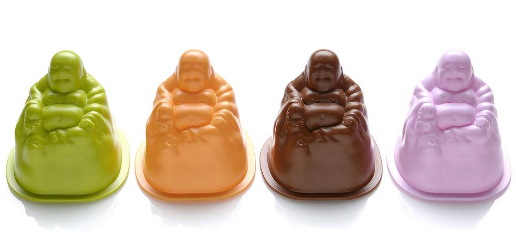A few years ago, my friend Brendan gave me a delightful gift that I absolutely adore — an ingenious set of dessert molds in the shape of little Buddhas — and I finally have gotten around to using them. Their name is a clever pun in Italian; “Buddhini” means “little Buddhas,” and is also a homophone of budini, or “puddings.”
I used a Thai jasmine-flavored agar dessert mix that you can easily find in most Asian food markets; it’s also available in almond flavor. You simply dissolve the powder mix in boiling water, pour into the molds, and refrigerate for at least an hour, or until firm. I supported each mold in a small bowl by bunching up paper towels and using them to prop the molds upside-down. You could also insert each one in an appropriately sized drinking glass or jar. Once they have set, unmold by gently squeezing each mold over a plate, and serve with an assortment of tropical fruit (fresh, canned, or a mixture). A refreshing dessert for the summer. Yes, I’m aware that it’s not yet summer in Boston — or anywhere near it — but I can dream, can’t I? I’m getting tired of root vegetables and hearty stews.
Want to try making Buddhini yourself? You can find more information on the molds — including many recipes and where to buy them — online here: http://www.nobodyandco.it. They’d also work great with ice cream, pudding, panna cotta, or any other type of dessert or savory treat that firms up in the fridge or freezer (they are not, unfortunately, oven safe).





